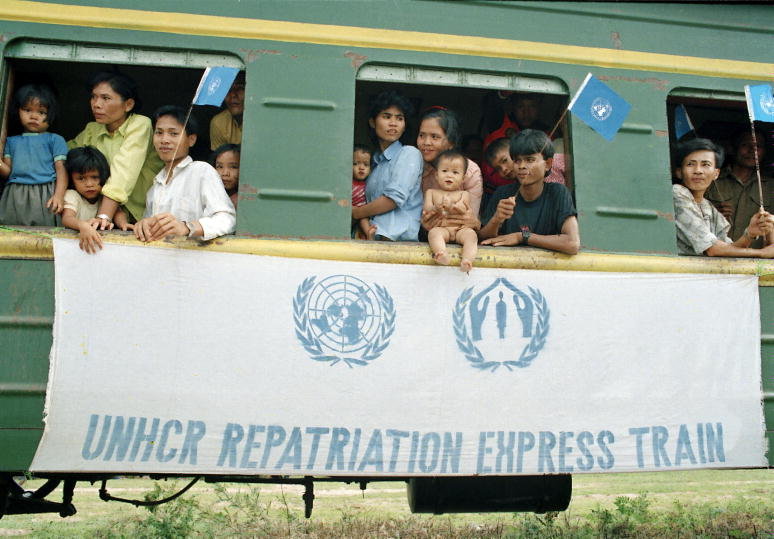
ប្រជាជនកម្ពុជាដែលត្រឡប់មកពីជំរុំជនភៀសខ្លួនជិះរថភ្លើងរបស់អង្គការ UNHCR (ការិយាល័យឧត្តមស្នងការអង្គការសហប្រជាជាតិទទួលបន្ទុកជនភៀសខ្លួន). រូបថត ដោយ UN Photo/P Sudhakaran ថតនៅថ្ងៃ ២៨ សីហា ១៩៩២. អាជ្ញាប័ណ្ណ CC BY-NC-ND 2.0
ចាប់តាំងពីកិច្ចព្រមព្រៀងសន្តិភាពទីក្រុងប៉ារីស នៅខែតុលា ឆ្នាំ១៩៩១ ប្រទេស កម្ពុជា បានទទួលជំនួយអន្តរជាតិជាច្រើនសម្រាប់ការអភិវឌ្ឍ និងការងារស្តាឡើងវិញក្រោយជម្លោះផ្សេងៗទៀត។ ការគាំទ្រនេះ រួមមានជំនួយដោយផ្ទាល់ កម្ចីសម្រាប់ការអភិវឌ្ឍ និងការផ្តល់មូលនិធិទៅលើហេដ្ឋារចនាសម្ព័ន្ធ ពីម្ចាស់ ជំនួយទ្វេភាគី ពហុភាគី និងឯកជន ។
ឆ្នាំ ២០១៤ គម្រោងថវិកាជាតិ ៣០ – ៤០ ភាគរយ ត្រូវទ្រទ្រង់ដោយជំនួយអភិវឌ្ឍន៍ផ្លូវការ ដែលធ្វើអោយកម្ពុជា ជាប្រទេសមួយក្នុងប្រទេសដែលមានអន្តរាគមន៍អន្តរជាតិខ្លាំងបំផុតលើពិភពលោក។1 ក្នុងឆ្នាំ ២០១២ ជំនួយអភិវឌ្ឍន៍ផ្លូវការ (ODA) មានចំណែក ៥.៧៤ ភាគរយនៃផលិតផលក្នុងស្រុកសរុបរបស់កម្ពុជា2 ហើយ ODA ក្នុងប្រជាជនម្នាក់ៗគឺ ៥៤ ដុល្លារ។3
យ៉ាងណាមិញ ជំនួយបរទេសផ្តល់មកប្រទេសកម្ពុជា (លើកលែងជំនួយពីចិន) បានធ្លាក់ចុះប្រមាណ ១៤ ភាគរយពីឆ្នាំ ២០១៤ ដល់ ២០១៥។4 ទិន្នន័យដែលបានមកពីអង្គការសម្រាប់ការអភិវឌ្ឍកិច្ចសហប្រតិបត្តិការសេដ្ឋកិច្ច រួមបញ្ជូលជំនួយបរទេសផ្តល់ពីប្រទេសម្ចាស់ជំនួយធំៗ និងទីភ្នាក់ងារអន្តរជាតិនានា ដូចជា ធនាគារអភិវឌ្ឍន៍អាស៊ី និងកម្មវិធីអភិវឌ្ឍន៍របស់អង្គការសហប្រជាជាតិ។ ការចំនាយនានានៃជំនួយ បានធ្លាក់ចុះពី ៩៧០ លានដុល្លារ មក ៨៣០ លានដុល្លារ។ ការប្តេជ្ញាថ្មីៗរបស់ម្ចាស់ជំនួយនានា បានថយចុះពី ១.៤៧ ពាន់លាន មកត្រឹម ១.១៧១ ពាន់លានប៉ុណ្ណោះ។5
ម្ចាស់ជំនួយបីធំៗមាន ប្រទេសជប៉ុន ធនាគារអភិវឌ្ឍន៍អាស៊ី (ADB) និង សហរដ្ឋអាមេរិច៖
- ឆ្នាំ២០១៤ ជំនួយមានសំណង ជំនួយឥតសំណង និងជំនួយបច្ចេកទេសរបស់ជប៉ុន មានតម្លៃសរុប ៤៩៥.៨១ លានដុល្លារសហរដ្ឋអាមេរិច។6
- ឆ្នាំ២០១៥ ជំនួយឥតសំណង ជំនួយមានសំណង និងជំនួយបច្ចេកទេស របស់ ADB មកកម្ពុជាសរុបគឺ ១៧១.១១ លានដុល្លារ សហរដ្ឋអាមេរិច។7
- ឆ្នាំ២០១៤ ជំនួយទៅកាន់បរទេសរបស់សហរដ្ឋអាមេរិចលើវិស័យសុខាភិបាល អប់រំ អភិបាលកិច្ច កំណើនសេដ្ឋកិច្ច និងការដោះមីន និងអាវុធយុទ្ធភ័ណ្ឌមិនទាន់ផ្ទុះ មានតម្លៃសរុបជាង ៧៤.៥ លានដុល្លារ សហរដ្ឋអាមេរិច។8
ធនាគារពិភពលោក ដែលបានដើរតួយ៉ាងសំខាន់ បានផ្អាកការផ្តល់កម្ចីថ្មីនៅក្នុងខែ សីហា ឆ្នាំ ២០១១ បន្ទាប់ពីត្រូវបានរិះគន់សម្រាប់ការគាំទ្ររបស់ខ្លួនដល់ការចុះបញ្ជីដីសម្រាប់ជនរងគ្រោះដែលត្រូវបានបណ្តេញចេញពីបឹងកក់ក្នុងរាជធានីភ្នំពេញ។ យ៉ាងណាមិញ ធនាគារនេះបានប្រកាសនៅក្នុងខែ ឧសភា ឆ្នាំ ២០១៦ ថាខ្លួននឹងផ្តល់កម្ចីថ្មី ១៣០ លានដុល្លារដល់ប្រទេសកម្ពុជា ដើម្បីផ្តល់មូលនិធិដល់គម្រោងកាត់បន្ថយភាពក្រីក្រ។9
ឯប្រទេសចិន ក៏បានឧបត្ថម្ភមកកម្ពុជាខ្លាំងក្លាដែរ ។ ក្នុងកំឡុងដំណើរទស្សនកិច្ចនៅទីក្រុងប៉េកាំង ឆ្នាំ២០១៣ និងឆ្នាំ ២០១៤ លោកនាយករដ្ឋមន្ត្រី ហ៊ុន សែន បានចុះហត្ថលេខាលើកិច្ចព្រមព្រៀងកម្ចីការប្រាក់ទាប និងជំនួយឥតសំណងមួយចំនួន។10 ហើយទិន្នន័យជំនួយ បានបង្ហាញថា គម្រោងចំនួន ១០២ ត្រូវបានទ្រទ្រង់ដោយប្រទេស ចិន ពីឆ្នាំ ២០១០ ដល់ ឆ្នាំ ២០១៤ សរុបជាង ៣,៩ ពាន់លានដុល្លារសហរដ្ឋអាមេរិច។11 យ៉ាងណាក្តី ដោយសារប្រទេស ចិន មិនបានធ្វើចំណាត់ថ្នាក់នូវជំនួយ របស់ខ្លួនទៅតាមបទដ្ឋានតែមួយរបស់ ODA ដូចនឹងម្ចាស់ជំនួយដទៃទៀត បរិមាណជំនួយជាក់ស្តែង ត្រូវបានធ្វើការប៉ាន់ប្រមាណទៅតាមលំហូដូច ODA។
ម្ចាស់ជំនួយយ៉ាងច្រើនបំផុតគឺជាហត្ថលេខីនៃគោលការណ៍គណៈកម្មាធិការជំនួយអភិវឌ្ឍន៍របស់ OECD ប៉ុន្តែការសម្រប សម្រួលរបស់ម្ចាស់ជំនួយនៅមិនទាន់គ្រប់គ្រាន់នៅប្រទេស កម្ពុជា ។ ដោយសារការ ពឹងផ្អែកលើជំនួយបរទេសរបស់ប្រទេស កម្ពុជា ធ្វើឲ្យបរិយាកាសនៃគោលនយោបាយអភិវឌ្ឍន៍ ដែលជា ញឹកញយ រចនាសម្ព័ន្ទទទួលប្រាក់ មានលក្ខណៈស្មុគស្មាញ ស្រពិចស្រពិល ។
បច្ចុប្បន្ននេះ គម្រោងអភិវឌ្ឍន៍របស់រាជរដ្ឋាភិបាលកម្ពុជា ត្រូវបានចែងក្នុងឯកសារយុទ្ធសាស្ត្រជាពីរ៖
- ផែនការយុទ្ធសាស្ត្រអភិវឌ្ឍជាតិ ២០១៤-២០១៨ (គ.ជ.អ.ប.) បង្ហាញពីយុទ្ធសាស្ត្រ គោលដៅ និងសូចនាករអំពីការអភិវឌ្ឍ។
- យុទ្ធសាស្ត្រសហការអភិវឌ្ឍ និងភាពជាដៃគូរ (DCPS) បញ្ញត្តិទំនាក់ទំនងរវាងរាជរដ្ឋាភិបាល ជាមួយនឹងដៃគូអភិវឌ្ឍ។12
នៅព្រះរាជាណាចក្រកម្ពុជា ពុំមានក្របខ័ណ្ឌច្បាប់ជាក់លាក់មួយដែលកំណត់ដោយឡែក ស្ដីពីម្ចាស់ជំនួយ និងជំនួយអភិវឌ្ឍន៍នៅឡើយ។ តែទោះជាគ្មានច្បាប់ដោយឡែកមួយក្ដី គណៈកម្មាធិការនីតិសម្បទា និងអភិវឌ្ឍន៍កម្ពុជា ដែលឋិតនៅក្រោមឱវាទក្រុមប្រឹក្សាអភិវឌ្ឍន៍កម្ពុជា (CDC) គឺជាស្ថាប័នមានសមត្ថកិច្ចស្នូលក្នុងការគ្រប់គ្រងជំនួយ។
ក្របខ័ណ្ឌច្បាប់មួយ ដែលគ្រប់គ្រងការប្រព្រឹត្តទៅនៃអង្គការមិនមែនរដ្ឋាភិបាលក្នុងស្រុក និងអន្តរជាតិ ដែលរាប់បញ្ចូលទាំងដៃគូអភិវឌ្ឍផង គឺតម្រូវអោយមាននៅក្នុងរដ្ឋធម្មនុញ្ញនៃព្រះរាជាណាចក្រកម្ពុជា។ (គណៈកម្មាធិការសហប្រតិបត្តិការដើម្បីកម្ពុជា ប៉ាន់ស្មានថា ក្នុងចំណោមអង្គការមិនមែនរដ្ឋាភិបាលអន្តរជាតិដែលបានចុះឈ្មោះនៅកម្ពុជាចំនួន ៥០៨ គឺមានតែ ៣២២ ស្ថាប័ន មានសកម្មភាពក្នុងឆ្នាំ ២០១១។13
រាជរដ្ឋាភិបាលជាអ្នកដើរតួសំខាន់ជាងគេក្នុងការកំណត់គោលនយោបាយអភិវឌ្ឍនៅកម្ពុជា ជាពិសេសតាមរយៈក្រុមប្រឹក្សាអភិវឌ្ឍន៍កម្ពុជា និងគណៈកម្មាធិការនីតិសម្បទា និងអភិវឌ្ឍន៍កម្ពុជា។ ស្ថាប័នទាំងពីរនេះ ជួយសម្រួលគោលនយោបាយដោយជំរុញអោយមានការចូលរួមពីក្រសួង ម្ចាស់ជំនួយ និងសង្គមស៊ីវិល តាមរយៈក្រុមការងារបច្ចេកទេស។14 គោលនយោបាយស្ដីពីម្ចាស់ជំនួយ និងជំនួយអភិវឌ្ឍន៍ របស់ប្រទេសកម្ពុជា គឺបង្កើតឡើងមួយផ្នែកធំដោយផ្អែកតាមគោលដៅអភិវឌ្ឍសហស្សវត្សរ៍ និងវាស់ស្ទង់តាមសូចនាករត្រួតពិនិត្យរួម (Joint Monitoring Indicators or JMIs) រវាងរាជរដ្ឋាភិបាល និងម្ចាស់ជំនួយ។
ជាមួយនឹងកាលបរិច្ឆេទដែលបានកំណត់ទុកពីមុន សម្រាប់គោលដៅអភិវឌ្ឍន៍សហស្សវត្សរ៍ ដែលត្រូវបាន អនុម័តកាលពីពាក់កណ្តាល ឆ្នាំ ២០១៥ បច្ចុប្បន្ន ត្រូវបានផ្តោតទៅលើ គោលដៅអភិវឌ្ឍន៍ប្រកបដោយ ចីរភាព (SDGs) ចំនួន ១៧ របស់អង្គការសហប្រជាជាតិ អនុម័តដោយប្រទេសជាសមាជិករបស់អង្គការ សហប្រជាជាតិ នៅខែ កញ្ញា ឆ្នាំ ២០១៥15 គោលដៅទាំងនេះ កំណត់នៅក្នុងរបៀបវារៈអភិវឌ្ឍន៍មួយ យ៉ាងទូលំទូលាយ សម្រាប់រដ្ឋាភិបាល និងអង្គការផ្តល់ជំនួយ ដូចគ្នា ។
ប្រទេសកម្ពុជាត្រូវបានឡើងពីចំណាត់ថ្នាក់ប្រទេសចំណូលទាប មកកាន់ចំណាត់ថ្នាក់ចំណូលទាបមធ្យមនៅក្នុងខែ កក្កដា ឆ្នាំ ២០១៦ ដោយធនាគារពិភពលោក។16 ការធ្វើចំណាត់ថ្នាក់ថ្មីនេះត្រូវបានផ្អែកទៅលើការប៉ាន់ប្រមាណរបស់ធនាគារទៅលើកំណើនជាតិសរុប កាលពីឆ្នាំកន្លងទៅ។
ធ្វើបច្ចុប្បន្នភាពចុងក្រោយ៖ ២៨ ធ្នូ ២០១៦
ឯកសារយោង
- 1. ធនាគារពិភពលោក. “ជំនួយអភិវឌ្ឍន៍ផ្លូវការសរុប និងជំនួយផ្លូវការដែលទទួលបាន (គិតជាដុល្លារស.រ.អា បច្ចុប្បន្ន).” ចូលអាន ២៥ មិថុនា ២០១៥. [ភាសាអង់គ្លេស] http://data.worldbank.org/indicator/DT.ODA.ALLD.CD.
- 2. ក្រសួងការបរទេសស.រ.អាមេរិក. “ទំនាក់ទំនងសហរដ្ឋអាមេរិកជាមួយកម្ពុជា.” កែប្រែចុងក្រោយ ២៩ សីហា ២០១៤.[ភាសាអង់គ្លេស] https://www.state.gov/u-s-relations-with-cambodia/
- 3. ធនាគារពិភពលោក. “ជំនួយអភិវឌ្ឍន៍ផ្លូវការ ក្នុងមនុស្សម្នាក់ៗ.” ចូលអាន ២៥ មិថុនា ២០១៥. [ភាសាអង់គ្លេស] http://data.worldbank.org/indicator/DT.ODA.ODAT.PC.ZS.
- 4. Michael Dickison. “ជំនួយបរទេសធ្លាក់ចុះនៅក្នុងបច្ចុប្បន្នភាពចុងក្រោយរបស់ OECD.” កាសែតខេមបូឌាដេលី, ចុះថ្ងៃទី ២៣ ខែ ធ្នូ ឆ្នាំ ២០១៦។
- 5. ដូចយោងខាងដើម។
- 6. ក្រសួងការបរទេសប្រទេសជប៉ុន. “ជំនួយអភិវឌ្ឍន៍ផ្លូវការ(ODA).” កែប្រែចុងក្រោយ ១១ មេសា ២០១៦.[ភាសាអង់គ្លេស] http://www.mofa.go.jp/policy/oda/page_000008.html#cambodia
- 7. ធនាគារអភិវឌ្ឍន៍អាស៊ី. “ធានាគារអភិវឌ្ឍន៍អាស៊ី និងកម្ពុជា៖ សលាកប័ត្រពត៌មានសង្ខេប.” កែប្រែចុងក្រោយ មេសា ២០១៦.[ភាសាអង់គ្លេស] http://www.adb.org/sites/default/files/publication/27757/cam_0.pdf
- 8. ក្រសួងការបរទេសស.រ.អាមេរិក. “ទំនាក់ទំនងសហរដ្ឋអាមេរិកជាមួយកម្ពុជា.” កែប្រែចុងក្រោយ ២៩ សីហា ២០១៤.[ភាសាអង់គ្លេស] https://www.state.gov/u-s-relations-with-cambodia/
- 9. សុខ ខេមរា. “កម្ចីធនាគារពិភពលោកនាំឱ្យមានចម្ងល់ពីបញ្ហាទំនុកចិត្ត.” វីអូអេកម្ពុជា, ចុះថ្ងៃទី ២៧ ខែ ឧសភា ឆ្នាំ ២០១៦។
- 10. ប្រាក់ ចាន់ថុល. “ចិនសន្យាផ្ដល់ជំនួយ ៥៤៨ លានដុល្លារដើម្បីចងសម្ព័ន្ធមិត្តជាមួយកម្ពុជា.” រ័យទើរ, ១០ មេសា ២០១៣. ចូលអាន ២៥ មិថុនា ២០១៥.[ភាសាអង់គ្លេស] https://www.reuters.com/article/us-cambodia-china-idUSBRE93909D20130410
- 11. ទិន្នន័យជំនួយ “ការតាមដានហិរញ្ញវត្ថុអភិវឌ្ឍរបស់ចិន”, ២០១០-២០១៤. កម្ពុជា។ ចូលអានថ្ងៃទី ១៣ តុលា ឆ្នាំ២០១៥។ http://china.aiddata.org/
- 12. ក្រុមប្រឹក្សាអភិវឌ្ឍន៍កម្ពុជា. “ការគ្រប់គ្រងជំនួយនៅកម្ពុជា”. ចូលអាន ២៥ មិថុនា ២០១៥. http://www.cdc-crdb.gov.kh/cdc/aid-management-cambodia.html
- 13. គណៈកម្មាធិការសហប្រតិបត្តិការដើម្បីកម្ពុជា (គ.ស.ក). ការចូលរួមរបស់អង្គការសង្គមស៊ីវិលដើម្បីការអភិវឌ្ឍនៅកម្ពុជា ២០១១. ភ្នំពេញ៖ គ.ស.ក, ២០១២. http://www.ccc-cambodia.org/downloads/publication/CCC-CSO%20Contributions%20Report.pdf
- 14. ក្រុមប្រឹក្សាអភិវឌ្ឍន៍កម្ពុជា. របាយការណ៍ប្រសិទ្ធិភាពជំនួយនៅកម្ពុជា. ភ្នំពេញ៖ រាជរដ្ឋាភិបាលកម្ពុជា, ២០១០. [ភាសាអង់គ្លេស] http://www.cdc-crdb.gov.kh/cdc/third_cdcf/aer_2010_en.pdf
- 15. អង្គការសហប្រជាជាតិ. “ប្រែក្លាយពិភពលោករបស់យើង៖ របៀបវារៈដើម្បីការអភិវឌ្ឍន៍ដោយនិរន្តរភាពឆ្នាំ ២០៣០ » ចូលអាន ១៣ តុលា ២០១៥. [ភាសាអង់គ្លេស] https://sustainabledevelopment.un.org/post2015/transformingourworld
- 16. Cam McGrath និង ហ័រ គឹមសាយ. “ស្ថានភាពសេដ្ឋកិច្ចប្រទេសកម្ពុជាបានឈានដល់កម្រិតប្រទេសចំណូលទាបមធ្យម.” កាសែតភ្នំពេញប៉ុស្តិ៍, ចុះថ្ងៃទី ០៥ ខែ កក្កដា ឆ្នាំ ២០១៦។

